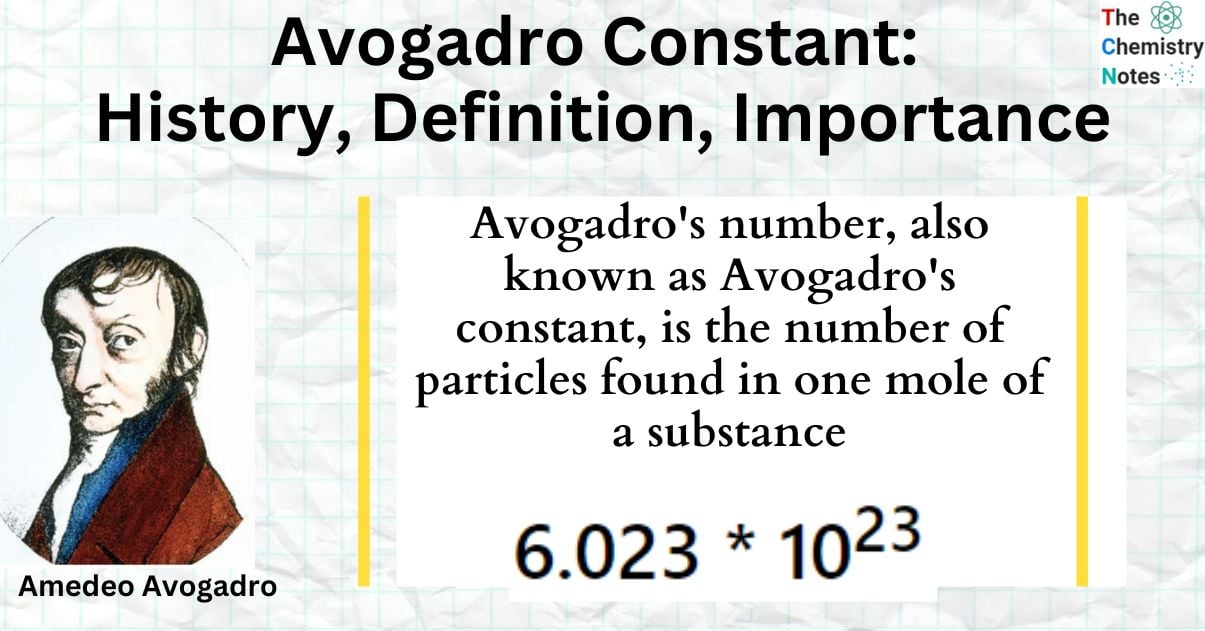The Avogadro constant is used to calculate moles. A mole is a chemical unit that represents 6.02214076 * 1023 entities. This is known as the Avogadro constant and is denoted by the symbol mol. To count atoms and molecules, chemists use mol (1 mol = 6.02 * 1023 = NA; Avogadro constant), as physicists use single particles, for example, the elementary charge of a single particle is e0 = 1.602 * 10− 19C (1C = 1 As = 6.24 * 1018 e±), to count charges.

Interesting Science Videos
What is Mole?
The mole, or “mol,” is a chemistry unit of measurement that refers to a very large number of molecules, atoms, or particles.
The mole, symbol mol, is the SI unit of the substance of a specified elementary entity, which may be an atom, molecule, ion, electron, any other particle, or a specified group of such particles; its magnitude is determined by fixing the numerical value of the Avogadro constant to be exactly 6.023 * 1023 when expressed in the SI unit mol-1. https://doi.org/10.1021/ed5007376
What is Avogadro’s Constant or Avogadro’s Number?
Avogadro’s number, also known as Avogadro’s constant, is the number of particles found in one mole of a substance. Also, the number of entities in a mole of any substance is defined by Avogadro’s constant. It is the same as 6.023 * 1023.
The symbol for Avogadro constant is represented as NA or L.
According to the type of substance, the units could be electrons, atoms, ions, or molecules.
Therefore, in 1 mole of sodium, there are 6.02 × 1023 sodium atoms and in 1 mole of sodium chloride (NaCl) there are 6.02 × 1023 sodium ions and 6.02 × 1023 chloride ions.
History of Avogadro Constant
The number Avogadro is named after the Italian scientist Amedeo Avogadro.

Avogadro proposed that the volume of a gas at a constant temperature and pressure was proportional to the number of particles it contained, but he did not propose a constant. Avogadro’s work was almost completely ignored until it was forcefully presented by Stanislao Cannizarro at the Karlsruhe Conference in 1860. He demonstrated that Avogadro’s Principle could be used to calculate not only molar masses but also atomic masses indirectly. Stanislao Cannizzaro named it after Amedeo Avogadro, who explained it four years after Avogadro’s death.
Jean Perrin, a French physicist, proposed Avogadro’s number in 1909. He received the Nobel Prize in Physics in 1926 for using several methods to calculate the value of the constant. Perrin’s value, on the other hand, was based on the number of atoms in one gram of atomic hydrogen. The constant was later redefined to be based on 12 grams of carbon-12.
How Avogadro’s number is calculated?
Accurate determinations of Avogadro’s number necessitate the measurement of a single quantity on both the macroscopic and atomic scales. Additionally, the same unit of measurement will be used for this measurement.
This became possible for the first time when American physicist Robert Millikan measured the charge of an electron. In addition, the Faraday charge, which has been known for a while, is the charge on a mole of electrons.
The best estimate of the value of a Faraday is 96,485.3383 coulombs per mole of electrons, according to the National Institute of Standards and Technology (NIST). Furthermore, 1.60217653 x 10-19 coulombs per electron is the best estimate of an electron’s charge based on modern experiments. If the charge on a mole of electrons is divided by the charge on a single electron, the result is Avogadro’s number, which is 6.02214154 x 1023 particles per mole.
There is another method for calculating Avogadro’s number. This method begins with careful macroscopic measurements of the density of an ultrapure sample of a material.
The Importance of Avogadro Constant
- It connects the macro and micro worlds by relating the amount of substance to the number of particles.
- Additionally, it shows how certain physical properties and constants relate to one another.
References
- Richard P. Feynman: The Feynman Lectures on Physics, Volume II
- “2018 CODATA Value: atomic mass constant”. The NIST Reference on Constants, Units, and Uncertainty. NIST. 20 May 2019. Retrieved 20 May 2019.
- https://www.studysmarter.co.uk/explanations/chemistry/physical-chemistry/avogadro-constant/
- https://www.thoughtco.com/definition-of-avogadros-number-604379
- https://chemistrytalk.org/mole-chemistry-avogadros-number/
- https://byjus.com/physics/avogadros-number/
